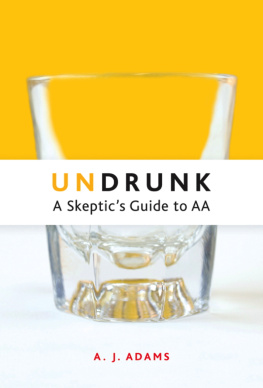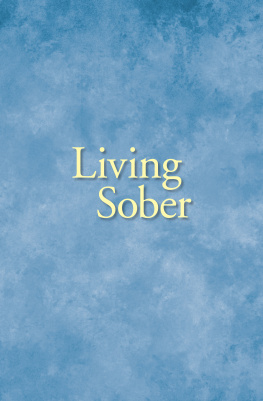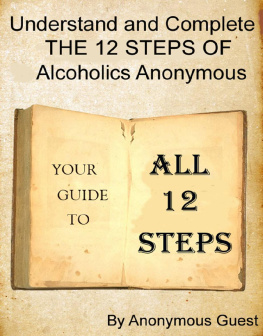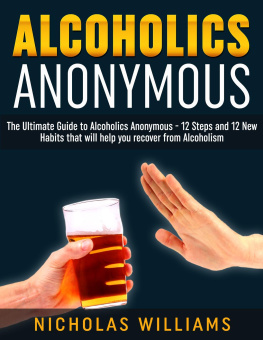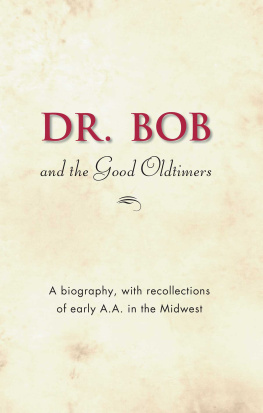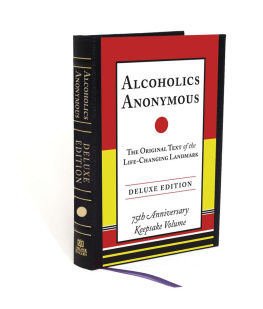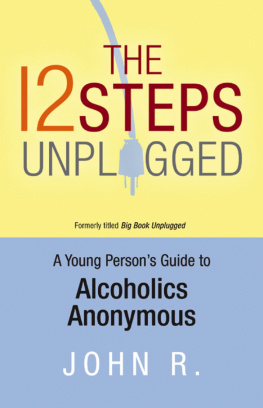My eyes wandered around the room, taking in the strange collection of humanity seeking to claim me as a fellow sufferer. If variety is the spice of life, this crowd was the jambalaya of affliction. Ted, sitting directly across the room from me, looked like he was taking a break from the Senior Tour: expensive pink sweater, silver hair, nice tan, Belgian loafers. Next to him, Rodney and Ruby looked as though theyd stepped out of the pages of Im a Biker and I Kill People magazine. Matching leather vests were adorned with dozens of little pins, no doubt memorializing some of their more notable crimes. They also sported patches with the mysterious circle/triangle thingy on their matching biker chaps...
... Buck was retired military, and Pete was a cop... I knew that Julie was an assistant district attorney because shed prosecuted most of my friends DUIs. She smiled at me. Probably had a concealed carry...
Bored with people-watching, I tuned into some of what was being said. The topic was gratitude, and boy, was this hapless collection of human misery full of it! They were grateful that the obsession to drink had been lifted, that their defects had been removed (a work in progress for some, I could see), that they were conquering fears, returning to health, banishing resentment, saving family life, and filling up bank accounts. The list was endless... I looked around for the Kool-Aid and checked my watch.
From chapter 1
Undrunk
A Skeptics Guide toAA
A. J. Adams
Foreword by Mel B.

Hazelden Publishing
Center City, Minnesota 55012
800-328-9000
hazelden.org/bookstore
2009 by A. J. Adams
All rights reserved. Published 2009
Printed in the United States of America
No part of this publication may be reproduced, stored in a retrieval system, or transmitted in any form or by any meanselectronic, mechanical, photocopying, recording, scanning, or otherwisewithout the express written permission of the publisher. Failure to comply with these terms may expose you to legal action and damages for copyright infringement.
Library of Congress Cataloging-in-Publication Data
Adams, A. J., 1950
Undrunk : a skeptics guide to AA / A.J. Adams; foreword by Mel B.
p. cm.
Includes bibliographical references.
ISBN 978-1-59285-720-3 (softcover)
1. Alcoholics Anonymous 2. AlcoholicsRehabilitation. 3. Recovering alcoholicsServices for. 4. Twelve-step programs. I. Title.
HV5278.A33 2009
616.86'106dc22
2008054850
Ebook ISBN: 978-1-59285-835-4
Editors note
The names, details, and circumstances may have been changed to protect the privacy of those mentioned in this publication.
This publication is not intended as a substitute for the advice of health care professionals.
Alcoholics Anonymous, AA, the Big Book, and the AA Grapevine are registered trademarks of AA World Services, Inc.
Unless otherwise noted, all quotations from Alcoholics Anonymous (the Big Book) are from the fourth edition, published in 2001 by AA World Services, Inc.
13 12 11 10 09 1 2 3 4 5 6
Cover design by Percolator
Interior design and typesetting by BookMobile Design and Publishing Services, Minneapolis
For Anita
I walked out of the fog and there you werewaiting for me.
Contents
Foreword
Theres a saying in Alcoholics Anonymous that nobody is too dumb to follow the Twelve Step program, but some alcoholics are too smart. Writing as an AA member with more than fifty-eight years of continuous sobriety, I can say that Ive met my share of people who have dismissed the program because of such unexamined biasesand their lives have not always ended well.
A. J. Adams showed signs of being such a person when he attended his first AA meetingsand he continued to drink. Along the way, however, he began to understand that AA was quietly changing lives that had been all but lost. He studied and accepted the program and found his life miraculously changing for the better in only one year. The experience was so remarkable that he wrote this book to explain what he had found in AA that gave him continued sobriety and a completely new approach to life.
While AA is often described as a simple program, A.J. goes behind the scenes to show that AA has real depth and to highlight how and why it works. By writing in a personal, friendly style laced with a wicked sense of humor, he makes it easy to digest some of the deeper principles that have given AA its lasting power.
Who should read this book? It is certainly aimed at people who think they have drinking problems but are skeptical about AA or are resisting going to a meeting. (I dont know many people who gladly attended their first meeting!) In addition, this book can be a good read for nonalcoholics who want to learn more about AAespecially if they think someone they care about has an alcohol or other drug problemand how it developed from a chance meeting of two drunks in 1935. And since there have been a number of recent books, articles, and Web sites critical of AA, its gratifying to have an advocate like A.J. who can lay out sound reasons why AA is still working well, not the least of which being that it saved his life and the lives of millions of others.
I think you will find yourself being pulled in to A.J.s story with the very first chapter. His first AA meeting in a shabby room in a rundown section of town was the kind of meeting that could be found anywhere in America. But, because he wasnt ready to accept the program and continued drinking until alcohol was, as he puts it, moving in for the kill, this meeting could have turned him permanently away from the fellowship. Almost against his will, though, he picked up a few good ideas about AA and got the message that he should keep coming back.
His real recovery started when the pain became excruciating, he lost his job (a common occurrence among unrecovered alcoholics and addicts), and his home life became terribly bleak and miserable. Prodded into rehab and humbled by defeat, he made a new beginning that worked this time. It is a story Ive heard hundreds of times in AA, and A.J. gives it new twists that will carry you along.
One of the unwritten rules of AA is that one should utilize the program rather than analyze it, because too much analysis is said to lead to paralysis. I dont think this warning applies to A.J.s discussion of what the AA program is and how and why it works, because it comes straight from the heart with no lecturing or proselytizing. Reviewing the history and development of AA, he concludes that AAs early years are a fascinating tale of serendipity and remarkable spiritual intervention. Youll also find him acknowledging the old-fashioned Yankee virtues that AA cofounders Bill W. and Dr. Bob picked up in their Vermont backgrounds. And if youre having trouble understanding the spirituality of the AA program, youll get some help from his take on the subject in chapter 3. He sees spirituality as its own reward, as a source of energy to face life with confidence.
Beyond that, youll find A.J. covering almost all of the AA basics in these pages: get a sponsor, attend meetings regularly, help yourself by helping others. You will even learn AA jargon and sayings that have evolved in the fellowship over the years. As he writes about all these topics, they seem to have fresh meaning for me, though Ive heard them for years.
When you reach A.J.s one-year progress report near the end of the book, I think youll feel, as I do, that he has earned the happiness and success that his AA journey has brought into his life. This book is not only a great introduction to AA for people who are looking for something more than the party line. It can also serve as a good reminder for newcomersand even oldtimers like meof what we need to be thinking, feeling, saying, and doing to stay on the right track as we trudge AAs Road of Happy Destiny.

